by Valerie Love
When I was growing up, I experienced chronic stomachaches. They came on without warning, and were frequent and horrible.
It was only when I began practicing yoga regularly in my 20s that the stomachaches began to taper off. My yoga practice not only helped to lower my stress levels, but it also helped to strengthen my digestion and regulate imbalances in my body.
Here are six postures that over time can help improve digestion in the body. Forward bends and twists offer a gentle compression of the abdomen, and help improve blood flow to the digestive organs.
Additionally, these calming postures help to activate the parasympathetic nervous system in the body. The parasympathetic nervous system is the opposite of our adrenaline-fueled “fight or flight” instinct, and instead stimulates resting activity in the body and also promotes elimination and cleansing.
- Hero’s pose (virasana)

Hero’s pose
In addition to giving a lovely stretch through the thighs, knees and ankles, hero’s pose can also improve digestion, and relieve bloating.
To come into the posture, kneel down on the mat with your feet pointing straight behind you, and the buttocks pressing down into the heels. Lift the heart space forward and up, and bring the backs of the hands to the thighs.
If sitting on the heels is uncomfortable for your knees, you can also place a block below the sits bones for support, or place a pillow between the buttocks and the heels. Close the eyes, and draw the awareness to the breath, breathing fully and deeply into the belly. This is a good one to try after a heavy meal.
- Half lord of the fishes pose (ardha matsyendrasana)

Half lord of the fishes pose
Twists such as Half lord of the fishes pose stimulate the liver and kidneys and help stimulate digestion. It can also help with menstrual pain and backache as well.
To come into the posture, make your way into a seated position, and bring the right heel to the left buttock and cross the left foot over the right knee, bringing the sole of the foot to the mat. Ground down through the sits bones, and inhale as you reach the crown of the head towards the sky to lengthen the spine.
On the exhale, hook the right elbow onto the far side of the left knee, pointing the fingers to the sky, and bring the left hand down to the earth behind the left hip. If you have tightness in the shoulders or low back, wrap the right arm around the knee, hugging it into the body as you deepen into the twist, rather than hooking the elbow. Repeat on the opposite side.
- Child’s pose (balasana)

Child’s pose, with arms back by heels
Child’s pose doesn’t stimulate digestion per se, but it does help to calm the body and the mind, which can alleviate stress and help prevent stomach-related issues such as ulcers and irritable bowel syndrome. It may also help combat nausea.
Come into a low kneeling position on the mat, with the toes facing straight behind you, and the hips on the heels. Raise the arms to lift the heart space on the inhale, and on the exhale, begin to hinge forward, bringing the hands forward down to the mat, and the chest onto the thighs.
Tuck the chin slightly, and bring the forehead to the earth. Breathe deeply and fully into the low back. If you have tight shoulders, you can also bring the hands back down towards the feet, instead of extending the arms forward. Try experimenting with opening the knees wide to the edge of the mat, with the big toes touching, and allow the belly to come down between the thighs.
- Half wind relieving posture (ardha pavana muktasana)

Half wind relieving posture
The name says it all, right? Forward bends help to provide gentle compression to the lower abdomen, which helps the wind in the body pass through.
Half wind relieving pose activates the ascending and descending colon, and also provides a gentle stretch to the low back.
Lie down on the mat, and draw the right leg in towards the body, interlacing the fingers on the shin just below the knee. Use the strength of the arms to draw the knee in towards the armpit, pressing the thigh down into the body just to the outside of the ribcage.
Bring a slight tuck into the chin, and flex the left foot, drawing the calf muscle closer to the earth. Repeat on the opposite side.
- Reclined bound angle (supta baddha konasana)

Reclined bound angle pose
How much do I love reclined bound angle pose? Let me count the ways. This posture is a hip opener, a heart opener, and oh so relaxing. Place a bolster or a couple of folded blankets under your back and it’s even more delightful.
There are heaps of good things going on in the body with this one: it gives a stretch to the abdomen, and stimulates the kidneys, bladder, reproductive organs, and circulatory system. This is my go-to posture to make me feel better if I’ve over-indulged in a big meal.
Lie back on the mat and bend the knees, bringing the soles of the feet together, and let the knees open out wide. Keep the feet a comfortable distance from the body. Allow the arms to rest along side the body with palms facing upward, and draw the shoulder blades down the back towards one another to gently elevate the heart space.
If the stretch is too intense on the hips or inner thighs, you can place a block or a bolster beneath the knees for support.
- Corpse Pose (Savasana)

Savasana
And finally, last but not least, savasana. A posture of complete relaxation that activates the parasympathetic nervous system and its function of “rest and digest.” How can you go wrong with that?
Come into a comfortable, neutral position, lying down on the mat with the head in line with the rest of the body. Allow the arms to rest along side the body with palms facing up, and the feet to open out as wide as is comfortable.
As in reclined bound angle pose, draw the shoulder blades down the back towards one another to open through the heart space, and soften the body, relaxing and releasing any spaces of tension. Close the eyes, and draw the awareness to the breath.
(Special thanks to my partner for the photos, and to the weather in Wellington for giving us a beautiful December day to do some yoga in the Botanic Gardens!)
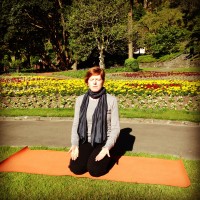
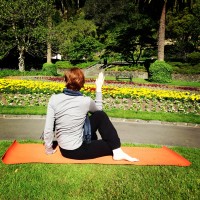
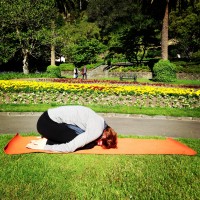
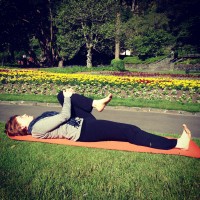
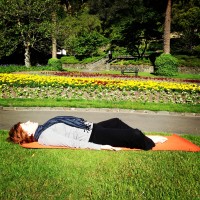
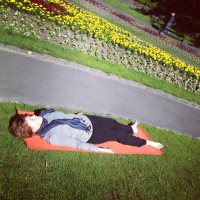
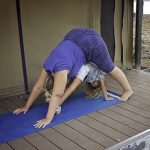
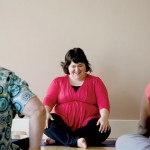
Any advice for irritable bowel syndrome?
Hi Tash,
Everyone is different, and I’m not a medical professional, so unfortunately I can’t offer specific advice. But in my yoga therapy training, we discussed IBS, and the benefits of activating the parasympathetic nervous system to improve bowel function. So the postures I’ve listed in the article– plus mindfulness meditation– can help to lower stress levels in the body, which often plays a role in IBS. Also, alternate nostril breathing (nadi shodana) can help too. You’ve probably already looked at your diet and the types of foods you’re eating, but that can play a huge role.
Hope that helps! Let me know if you have any other questions.
Warmly,
Valerie